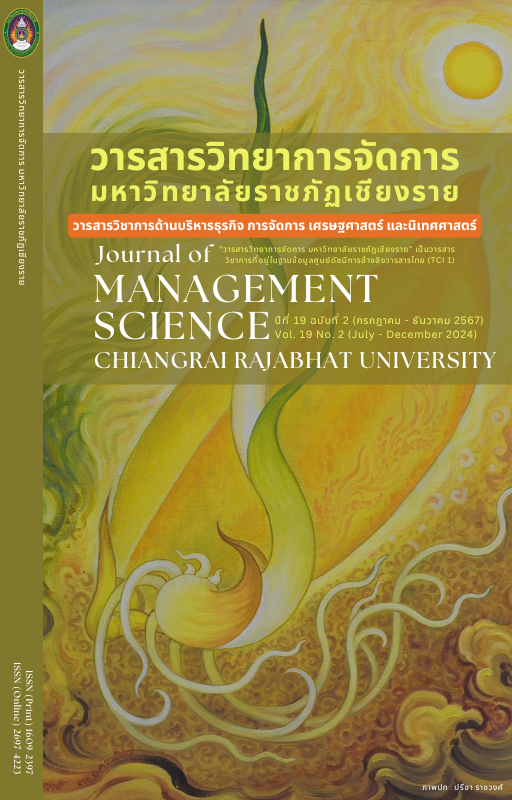Behavioral Intention Regarding Faith-Based Tourism in Maha Sarakham Province
Main Article Content
Abstract
This research has specific goals and aims. The objectives of this study are: 1) to examine the behaviour of tourists, 2) to analyse the tourist attractions they visit, and 3) to investigate the behavioural intentions of tourists in terms of their beliefs and attitudes in Maha Sarakham Province. The study will be conducted from October 2021 to September 2022, use a questionnaire with a sample size of 400 individuals engaged in faith-based tourism in Maha Sarakham Province. The researchers employed purposive sampling. Subsequently, the data underwent analysis by the application of descriptive statistics. The research revealed that behaviourists have a specific motive for their travels based on their observed behaviour. 63.7 percent of people enjoy travelling to different places. Monthly travel frequency. Infrequently, the percentage is 58.3 percent. Number of companions for travel: 1 individual. The value is 26.4 percent. 2. The type of vehicle you utilise for transportation. Individual-owned vehicles: 59.9% of the respondents had a travel duration of less than 24 hours; 49.0% had travel costs amounting to 1,000 baht or below; 51.9% obtained information about tourist sites in this province from which media source? The Internet, websites, and social networks contribute significantly (48.9%) to the overall appeal of tourism. Specifically, they have a high level ( \bar{x} =4.40) of influence on the value of tourist attractions. Does it reach the maximum level ( \bar{x} = 4.49)? The sub-factors include "Introduction to the family," which has the highest level of ( \bar{x} =4.59), and the general issue of loyalty to travelling, which is at a high level of ( \bar{x} =4.38). Regarding the sub-factor, loyalty towards travelling and visiting is observed. Is it the maximum level ( \bar{x} =4.59)
Article Details

This work is licensed under a Creative Commons Attribution-NonCommercial-NoDerivatives 4.0 International License.
Views and opinions expressed in the journal do not necessarily reflect those of the editors.
References
Alegre, J., & Cladera, M. (2009). Analyzing the effect of satisfaction and previous visits on tourist and Its Consequences. Journal of Basic and Applied Scientific Research, 9(1), 1557-1560.
Boonlert, J. (2015). Marketing management for the tourism industry. Nonthaburi: Press and Design. (in Thai)
Chalongsri, P. (2001). Tourism market planning and development. Bangkok: Faculty of Humanities Kasetsart University. (in Thai)
Chanan, W. (2017). Management of cultural resources for sustainable tourism. Nakhon Pathom: Printing House.
Chatthip, N. (1997). History community culture and the Thai nation. Bangkok: Chulalongkorn University. (in Thai)
Crompton, J. L. (1979). Motivations for Pleasure Vacation. Annals of Tourism Research, 6(1), 408-424.
Kanlaya, W. (2003). Advanced statistical analysis with SPSS for Windows (3rd ed.). Bangkok: Thammasan. (in Thai)
Kannika, K. (2015). Temples and religion in the tourism dimension. Khon Kaen: Khon Kaen University. (in Thai)
Klangnurak, H., & Pasunon, P. (2022). A Study of Canonical Correlation between Service Quality and Consumer Behavioral Intention of Spa Business Customers in Phuket Province. Journal of Southern Technology, 15(2), 12–21.
Lee, S. Y., Patrick, J. F., & Crompton, J. (2007). The roles of quality and intermediary constructs. New Jersey: Prentice Hall.
Lertphorn, P. (2015). Tourist behavior. Bangkok: Dhurakij Pundit University.
Maha Sarakham Provincial Tourism and Sports Office. (2023). Maha Sarakham Province Tourism Development Plan. Maha Sarakham: Maha Sarakham Provincial Tourism and Sports Office. (in Thai)
Maha Sarakham Provincial Statistical Office. (2023). Statistics on tourism and sports in Maha Sarakham Province. Maha Sarakham: Maha Sarakham Provincial Statistical Office. (in Thai)
Ministry of Tourism and Sports. (2022). Report on the Thai tourism economy, 2nd quarter 2022. Bangkok: Ministry of Tourism and Sports. (in Thai)
Na, S. A., Onn, C. Y., & Meng, C. L. (2016). Travel intentions among foreign tourists for medical treatment in Malaysia: An empirical study. Procedia-Social and Behavioral Sciences, 224(1), 546-553.
Phopphon, O., & Yaowapha, P. (2013). Service quality model. Image of tourist attractions and Satisfaction affecting the behavioral intention of long-stay tourism of Europeans and American. Thammasat Journal, 32(1), 35-50. (in Thai)
Phatthamuk, P., & Teerawat C. (2022). Model of causal relationships of factors affecting intentions behavioral analysis of Generation C tourists in museum tourism during the epidemic situation COVID-19. Journal of Corporate Management and Local Innovation, 8(9). 148-162. (in Thai)
Pramet, P. (2018). Management of religious tourism on Hong Kong Island that influences tourists. Bangkok: Thammasat University. (in Thai)
Ranee, I. (2014). Specialized tourism management. Bangkok: Sukhothai Thammathirat Open University. (in Thai)
Rovinelli, R.J., & Hambleton, R.K. (1977). On the use of content specialists in the assessment of criterion-referenced test item validity. Dutch Journal of Educational Research, (2), 49-60.
Setsri, P., Na Thalang, C., Wongmontha, S., & Pomsuwanet, S. (2023). Behavior of Thai tourists and decision to travel for cultural tourism According to the cultural identity of Yasothon Province. Valaya Alongkorn Review of Management Science, 4(1), 56-73. (in Thai)
Schiffman, G., & Kanuk, L. (2003). Customer Behavior (5th ed.). New Jersey: Prentice Hall.
Seow, A. N., Choong, Y. O., Moorthy, K., & Chan, L. M. (2017). Intention to visit Malaysia for medical tourism using the antecedents of theory of planned behavior: A predictive model. International Journal of Tourism Research, 19(3), 383-393.
Steven, P. & Stephen, J. (2013). Destination Marketing Organizations and destination marketing: A narrative analysis of the literature. Tourism Management, 87(1), 202-227.
Suparerk, H., & Thanakrit, S. (2023). Factors affecting satisfaction and business intentions behavior of tourists visiting Kaeng Krachan National Park. The New Viridian Journal of Arts, Humanities and Social Sciences, 3(5), 50-68. (in Thai)
Zeithaml, A., Berry, L. & Parasuraman, A. (1996). The behavioral consequences of service Quality. Journal of Marketing, 60(2), 31-46.


